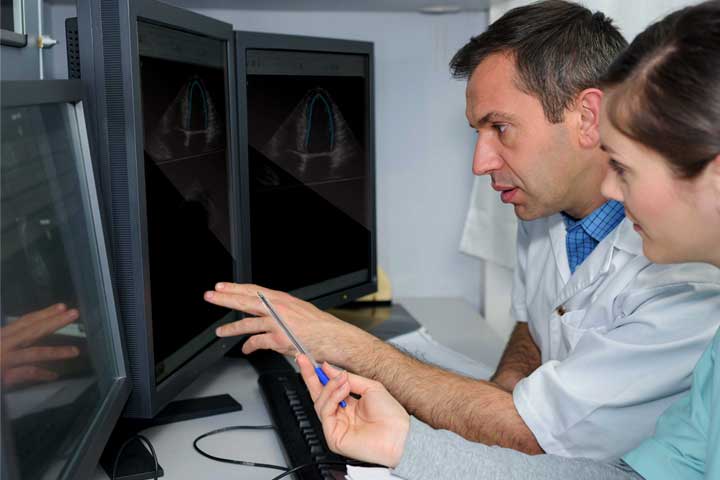
Latest research: zero variability echocardiography analysis
- | By Ultromics
- Articles
Advances in technology and artificial intelligence offer ways to eliminate variability in echocardiography. Several studies have shown that Ultromics' fully automated platform improves reproducibility and standardization.
The purpose of AI platforms like Ultromics is to offset manual tasks that inherently involve human error.
Manual measurements are never fully reproducible; this refers not only to intra-observer variability (difference in repeated measurements by the same observer), but also to inter-observer variability (differences in measurements between observers).
Ultromics offers standardization by fully automating analysis as part of a cloud service, with complete reproducibility, improved precision and increased efficiency. Patients receive the same high level of detection, regardless of the clinician's expertize.
Keep reading to see two pieces of research from Ultromics that show a significant reduction in variability when their platform is used in clinical workflow.
Fully automated quantification of contrast and non-contrast echocardiograms eliminates inter-operator variability (ASE)
While most research indicates reduced variability in reporting, one study posted at ASE 2022 suggests that Ultromics' fully automated quantification of contrast and non-contrast echocardiograms completely eliminates inter-operator variability.
The technology contours and makes calculations based on 10 years on known cardiac outcomes, accurately making predictions that are robust enough for clinical application, including quantifying left ventricular global longitudinal strain (GLS), volumes, and ejection fraction (EF). [1]
The study found that in all cases of processing of the same images, no variation was observed (0 RMSE, Bias and Limits of Agreement for EF, GLS and Volumes). A greater degree of inter-operator variation was observed for the semi-automated application under the same conditions.
A nominal AUROC, of 0.998 was produced for the contrast/non-contrast detection model and the Dice Coefficient for auto-contouring accuracy was 0.932 and 0.924 for contrast and non-contrast images, respectively.
Read more about the study here: Fully automated quantification of contrast and non-contrast echocardiograms eliminates inter-operator variability.
Human vs artificial intelligence-based echocardiography analysis as predictor of outcomes (WASE-COVID study)
A new study from the World Alliance Societies of Echocardiography (WASE), a major international research initiative led by the American Society of Echocardiography (ASE), suggests Ultromics is superior to human experts when it comes to predicting cardiac-related death, and can was found to significantly reduce variability when compared to manual measurements.
Researchers looked at 870 patients admitted for acute COVID-19 from January to September 2020. Patients were admitted to 13 hospitals in 9 countries. According the study, the patients all underwent transthoracic echocardiography (TTE), the leading procedure for assessing COVID-19 patients as it can evaluate the full spectrum of involvement, and it can be performed safely at the bedside or in the ICU. [2]
Ultromics helped clinicians AI achieve more accurate predictions of these mortalities than manual interpretation.
- AI analysis had lower variability than manual analysis for both LVEF (P = .003) and LVLS (P = .005).
- Inter-operator agreement for LVEF and GLS was 23% and 44% (respectively) lower for manual measurements than that achieved by the AI.
Additionally, the study found that variability between measurements on the same patient was significantly reduced when Ultromics' AI platform was used. In fact, it almost removed measurement errors introduced in the presence of an operator (0.18% EchoGo, 49.39% manual).
Read more about the study here: Human versus Artificial Intelligence–Based Echocardiographic Analysis as a Predictor of Outcomes: An Analysis from the World Alliance Societies of Echocardiography COVID Study.
Reducing variability can be a challenging task, but today's technology can help improve standardization, precision, and reproducibility. With Ultromics solutions, healthcare professionals can make more precise, efficient and informed decisions.
References:
- EchoGo’s fully automated quantification of contrast and non-contrast echocardiograms completely eliminates inter-operator variability
- Asch FM, Descamps T, Sarwar R, et al. Human versus Artificial Intelligence-Based Echocardiographic Analysis as a Predictor of Outcomes: An Analysis from the World Alliance Societies of Echocardiography COVID Study. Journal of the American Society of Echocardiography. 2022;35:1226-1237.e7
Curious about upcoming research and innovation?
Sign up to hear about the latest news.



.jpg)

